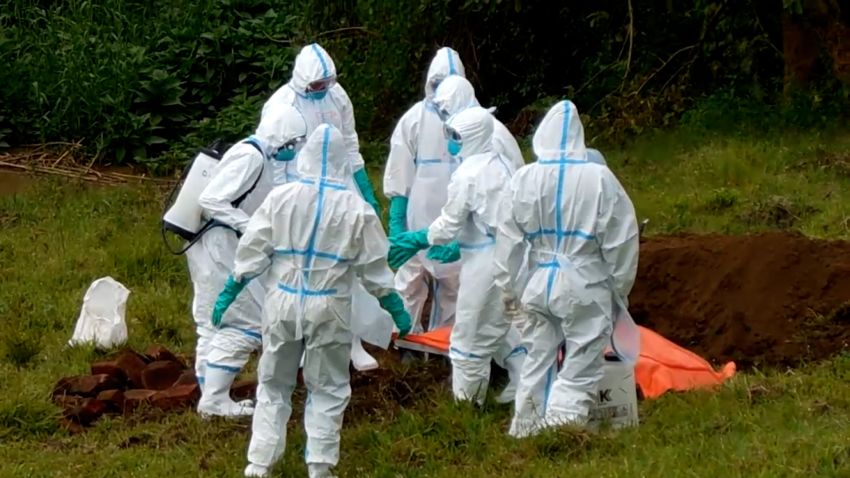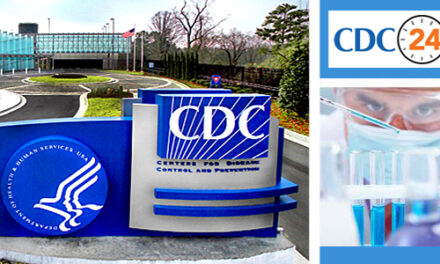
As Ebola outbreak grows in Uganda, US ramps up preparedness plans


How Uganda is fighting to contain another Ebola outbreak
02:30 – Source: CNN
CNN —
Uganda has been struggling with an Ebola outbreak for months, and although there have been no suspected or probable Ebola cases identified in the United States, federal and local health officials are working together to prepare for the possibility that the virus will spread across the Atlantic.
The US Centers for Disease Control and Prevention and the Administration for Strategic Preparedness and Response have conducted tabletop exercises with officials from five jurisdictions where airline passengers arriving in the US from Uganda are being funneled, the CDC confirmed Monday.
The agency said the exercises involved plans for managing a suspected case in each jurisdiction under three scenarios: when the potential patient is identified at a funneling airport, is identified during state monitoring of returned travelers from Uganda or seeks care at a hospital.
“This is an opportunity to learn about jurisdictions’ plans and identify any areas where CDC or our federal partners could offer technical or other assistance,” CDC spokesperson Kristen Nordlund wrote in an email to CNN. However, she noted, “The risk of Ebola in the United States is low.”
Uganda health authorities declared an outbreak of Ebola virus disease in September, and as of early November, 136 confirmed cases, 21 probable cases and 53 confirmed deaths have been identified there, according to the World Health Organization.
Last week, Ugandan Education Minister Janet Museveni announced that schools will end the current term two weeks earlier than scheduled in an effort to minimize contact among students and curb the spread of the virus.
“All primary and secondary schools in Uganda are directed to close by November 25th, 2022 for third term holidays as a measure to contain Ebola Virus Disease (EVD) in the country,” Museveni said in a statement. Eight students have died from Ebola since September, out of 23 confirmed cases in schools.
The general attitude among public health officials in the US is that as the outbreak in Uganda continues, it raises the likelihood of the virus spreading to the United States, said Lori Tremmel Freeman, chief executive officer of the National Association of County and City Health Officials.
“It might be just a matter of time,” Freeman said. “That is why every minute right now is being spent to ramp up the preparedness and response in anticipation of that single event occurring. But the more that we put our time and effort into this stage of the crisis, the better off we’ll be when we do get that first case.”
Officials at the CDC have been conducting their “tabletop exercises” with local health departments deemed to be at higher risk of seeing a case in their jurisdiction, Freeman said.
“Jurisdictions where the highest probability of cases may be are either because they represent Ugandan communities in this country, or they’re near those airports where Uganda travelers are being channeled,” she said.
Since early October, all passengers arriving to the US from Uganda have been routed to airports in New York; Newark, New Jersey; Atlanta; Chicago; or Washington, DC, for enhanced screening in response to the outbreak.
“So they will be walking through plans, identifying gaps and concerns,” Freeman said. “One of the areas that is the most hard to deal with for Ebola is what to do with a patient once identified and how you sustain quarantine for that person and their close contacts.”
These plans also include preparing community hospitals for the possibility of cases, and “efforts will be taking place soon to assess community front-line hospitals to determine their capacity and gaps,” Freeman said.
The CDC estimates that 20% of travelers from Uganda will arrive without a cell phone or US-based phone number. As of Monday morning, the CDC has distributed 163 cell phones to people arriving from Uganda who otherwise did not have ways to remain in contact with health officials.
The Chicago Department of Public Health is one of the agencies that has “participated in an exercise with CDC to walk through scenarios of a traveler developing symptoms suggestive of Ebola virus disease,” according to an emailed statement from the department.
“The City of Chicago and CDPH had existing Ebola response and operational plans that have been revised to address this specific 2022 outbreak; from screening and assessment to transportation and clinical care as deemed appropriate,” the statement says.
“CDPH continues to work with our hospitals to screen patients for travel history and be alert for symptoms of Ebola virus disease or, more likely, malaria or circulating respiratory viruses. In addition, CDPH is monitoring travelers for 3 weeks after their departure from Uganda and providing these travelers with CDPH contacts, should they develop symptoms.”
As of Wednesday, 824 travelers have been screened at O’Hare airport in Chicago, according to the department.
In Washington, health officials have monitored 100 travelers, of whom “19 are currently being monitored,” DC Health said Tuesday.
In New York, screening has been taking place at JFK airport, and the state health department has been working closely with the CDC.
“New York State is coordinating with CDC and local health departments as it screens people traveling from Uganda, where cases of Ebola have been identified,” Samantha Fuld, a spokesperson for the New York State Department of Health, wrote in an email to CNN.
“While there are no reported infections outside of Uganda or in New York or the United States, proactive measures by CDC to monitor key travel hubs – including JFK International Airport, one of one of five U.S. airports where CDC is now routing travelers from Uganda – alert public health laboratories, ready hospitals designated as Ebola treatment centers, and inform health care providers will ensure we remain vigilant and prepared,” Fuld wrote.
The Ebola virus is transmissible – but not as transmissible as some other infectious diseases, like Covid-19. “We should remain vigilant but not panic” about the risk of the virus spreading outside Uganda, said Dr. Dan Barouch, a professor at Harvard Medical School and Director of the Center for Virology and Vaccine Research at Beth Israel Deaconess Medical Center.
Ebola can spread from person to person through direct contact with blood or other bodily fluids such as saliva, sweat, semen or feces, or through contaminated objects like bedding or needles.
Ebola symptoms include fever, aches and pains, and fatigue, which then can progress to diarrhea, vomiting and unexplained bleeding. There are two monoclonal antibody treatments for Ebola approved by the US Food and Drug Administration. Supportive care includes giving fluids and electrolytes, supporting the patient’s blood pressure, reducing vomiting and managing fever and pain.
“If we do see any cases in the United States, the hope is that they will be identified quickly before there is further spread,” Barouch said.
“We need to be prepared. We need to make sure that our testing schemes are in place,” he said. “We need to have the protocols in place if there’s an infected traveler who arrives in the United States, for that person to get optimal medical care, but also to ensure that it doesn’t spread further.”
Source: https://www.cnn.com/2022/11/16/health/ebola-us-preparedness-cdc/index.html

















